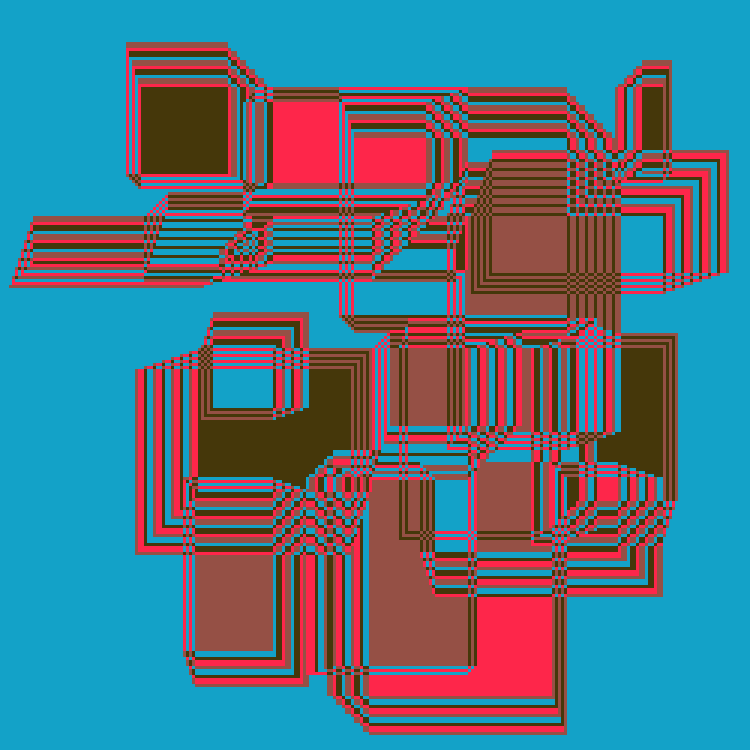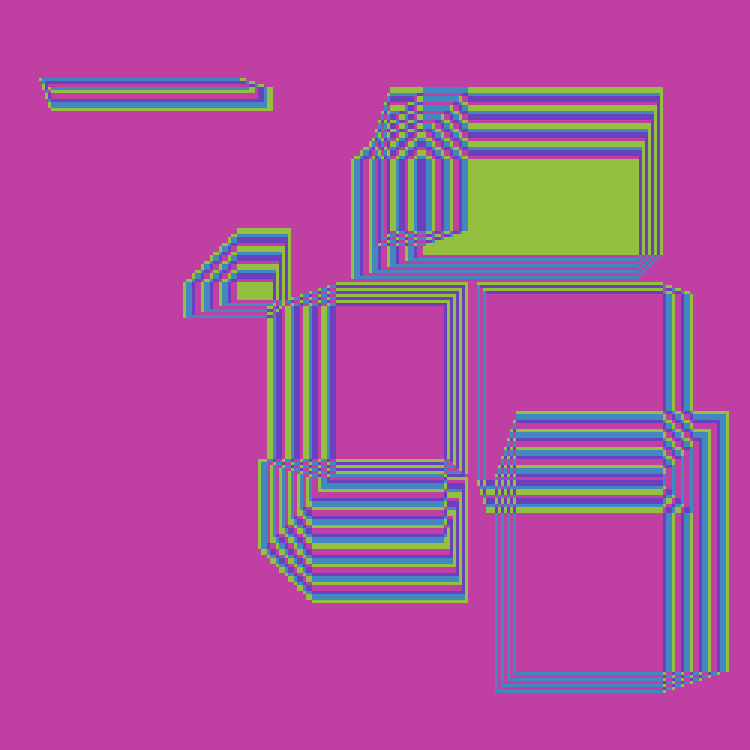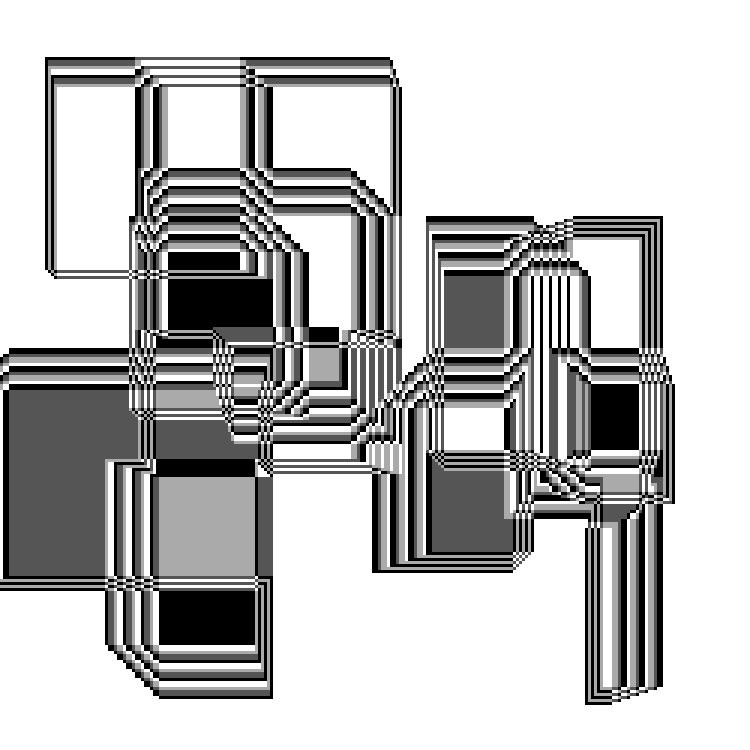Superimposed Rectangles
IPFS

14 August 2022•TEZOS•IPFS
Superimposed Rectangles
This is the fifth in series of works where we pay homage to Ken Knowlton, scientist and computer graphic pioneer and artist who passed on June 16, 2022. Ken Knowlton developed the famous EXPLOR language, (Explicit 2-D Patterns, Local Operations, and Randomness) while at Bell Labs. He published a paper describing it in 1975 entitled: MINI-EXPLOR, A FORTRAN-Coded Version of the EXPLOR Language for Mini (and larger) Computers. (https://dl.acm.org/doi/10.1145/988049.988052)
Superimposed Rectangles is my variation of one of Knowlton’s test examples: Contour Plot of Superimposed Octagonal Pyramids (Example 3). As Christopher Scussel continues to revamp the EXPLOR engine I endeavor to understand its capabilities as an aesthetic tool.
The inherent qualities of an original EXPLOR image is it is low resolution and uses a 4 gray scale color palette. When it was used in the 1970’s images were often generated this way as a series of frames then recorded on film and manipulated in post production. In this image we use a higher resolution (250x250) and employ 3x3 “blocks” of pixels instead of alphanumeric character combinations that we can render in 24bit color.
THE EXPLOR language consists of a set of functions that manipulate the contents of an internal array. Each element in internal display memory maps into a block in the output image. The CHANJ() function places rectangular areas of blocks over previously drawn sections in internal memory and more important, it applies rules that look at the current state of a particular array element and applies a rule to change that element. The trick is how to make this visually interesting.
I employ a grid structure to distribute a rectangular widget across the picture plane. The widget is a randomly defined area that grows in a random direction based on a set of random variables. During each iteration the new area overwrites internal memory (following a set of rules). I think this variation looks and feels like Knowlton’s Example 3 and maintains the EXPLOR vibe. The rectangles interact to form dimensional depth and an architectural quality.
We continue to honor the passing of Ken Knowlton with this NFT series. Here is an opportunity to collect an example image from the famous program he authored now updated by Scussel and Kolomyjec. A true piece of Computer Graphic Art history with a modern twist.
(c)2022 Dr. Bill Kolomyjec and Christoper Scussel. All rights reserved.
This is the fifth in series of works where we pay homage to Ken Knowlton, scientist and computer graphic pioneer and artist who passed on June 16, 2022. Ken Knowlton developed the famous EXPLOR language, (Explicit 2-D Patterns, Local Operations, and Randomness) while at Bell Labs. He published a paper describing it in 1975 entitled: MINI-EXPLOR, A FORTRAN-Coded Version of the EXPLOR Language for Mini (and larger) Computers. (https://dl.acm.org/doi/10.1145/988049.988052)
Superimposed Rectangles is my variation of one of Knowlton’s test examples: Contour Plot of Superimposed Octagonal Pyramids (Example 3). As Christopher Scussel continues to revamp the EXPLOR engine I endeavor to understand its capabilities as an aesthetic tool.
The inherent qualities of an original EXPLOR image is it is low resolution and uses a 4 gray scale color palette. When it was used in the 1970’s images were often generated this way as a series of frames then recorded on film and manipulated in post production. In this image we use a higher resolution (250x250) and employ 3x3 “blocks” of pixels instead of alphanumeric character combinations that we can render in 24bit color.
THE EXPLOR language consists of a set of functions that manipulate the contents of an internal array. Each element in internal display memory maps into a block in the output image. The CHANJ() function places rectangular areas of blocks over previously drawn sections in internal memory and more important, it applies rules that look at the current state of a particular array element and applies a rule to change that element. The trick is how to make this visually interesting.
I employ a grid structure to distribute a rectangular widget across the picture plane. The widget is a randomly defined area that grows in a random direction based on a set of random variables. During each iteration the new area overwrites internal memory (following a set of rules). I think this variation looks and feels like Knowlton’s Example 3 and maintains the EXPLOR vibe. The rectangles interact to form dimensional depth and an architectural quality.
We continue to honor the passing of Ken Knowlton with this NFT series. Here is an opportunity to collect an example image from the famous program he authored now updated by Scussel and Kolomyjec. A true piece of Computer Graphic Art history with a modern twist.
(c)2022 Dr. Bill Kolomyjec and Christoper Scussel. All rights reserved.
I've been involved in making art with the computer since the early 1970's. I’m one of the few early pioneers who’s still practicing Generative Art today.
128 EDITIONS
•7 RESERVES
minted
121 / 128
fixed price
5 TEZ
Lorem ipsum project longer longer
0.00001 ETH
Lorem ipsum project longer longer
0.00001 ETH
Lorem ipsum project longer longer
0.00001 ETH
Lorem ipsum project longer longer
0.00001 ETH
Lorem ipsum project longer longer
0.00001 ETH
Lorem ipsum project longer longer
0.00001 ETH
Lorem ipsum project longer longer
0.00001 ETH
Lorem ipsum project longer longer
0.00001 ETH
Lorem ipsum project longer longer
0.00001 ETH
Lorem ipsum project longer longer
0.00001 ETH
Lorem ipsum project longer longer
0.00001 ETH
Lorem ipsum project longer longer
0.00001 ETH
Lorem ipsum project longer longer
0.00001 ETH
Lorem ipsum project longer longer
0.00001 ETH
Lorem ipsum project longer longer
0.00001 ETH
Lorem ipsum project longer longer
0.00001 ETH
Lorem ipsum project longer longer
0.00001 ETH
Lorem ipsum project longer longer
0.00001 ETH
Lorem ipsum project longer longer
0.00001 ETH
Lorem ipsum project longer longer
0.00001 ETH
Lorem ipsum project longer longer
0.00001 ETH
Lorem ipsum project longer longer
0.00001 ETH
Lorem ipsum project longer longer
0.00001 ETH
Lorem ipsum project longer longer
0.00001 ETH























